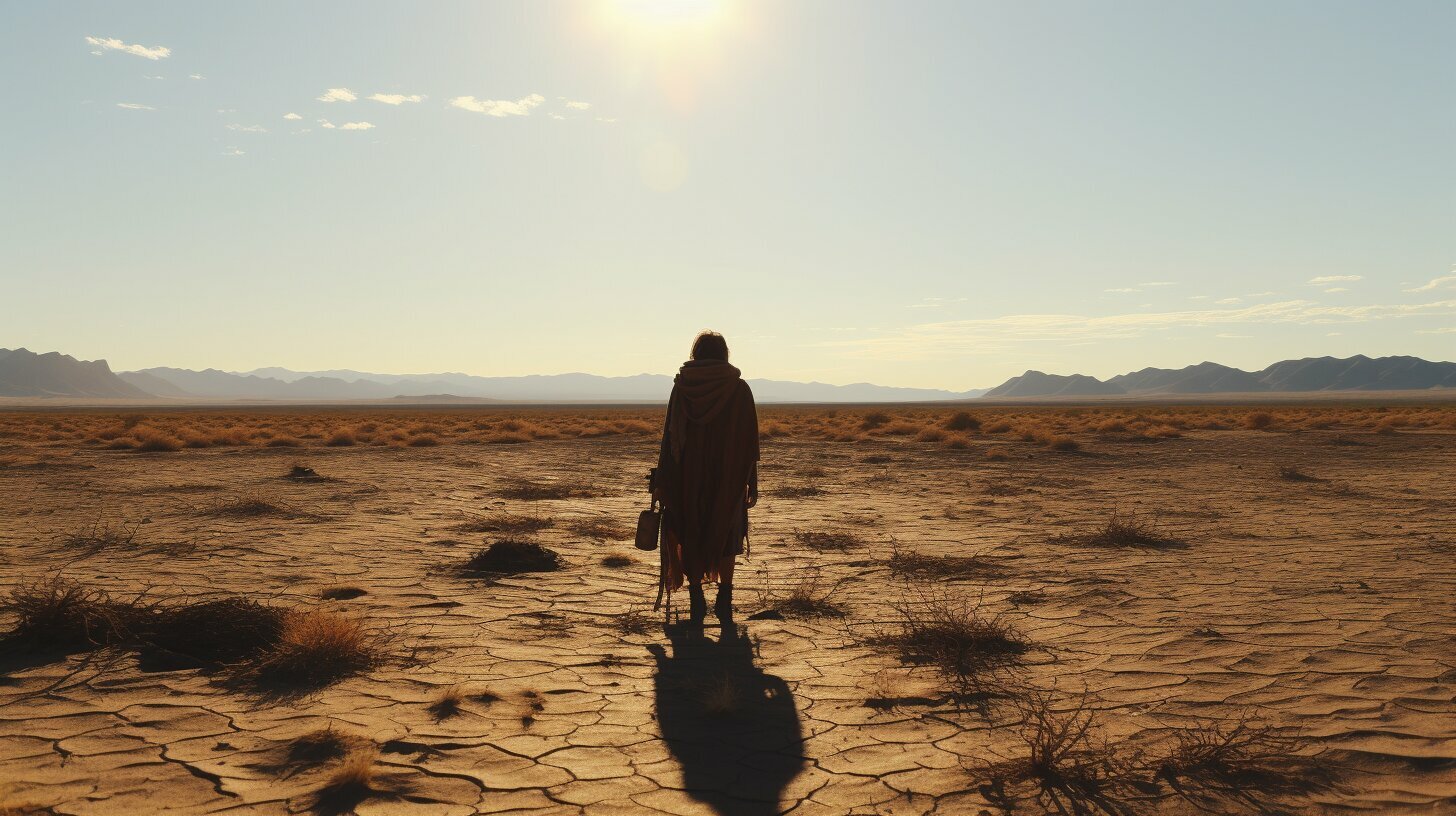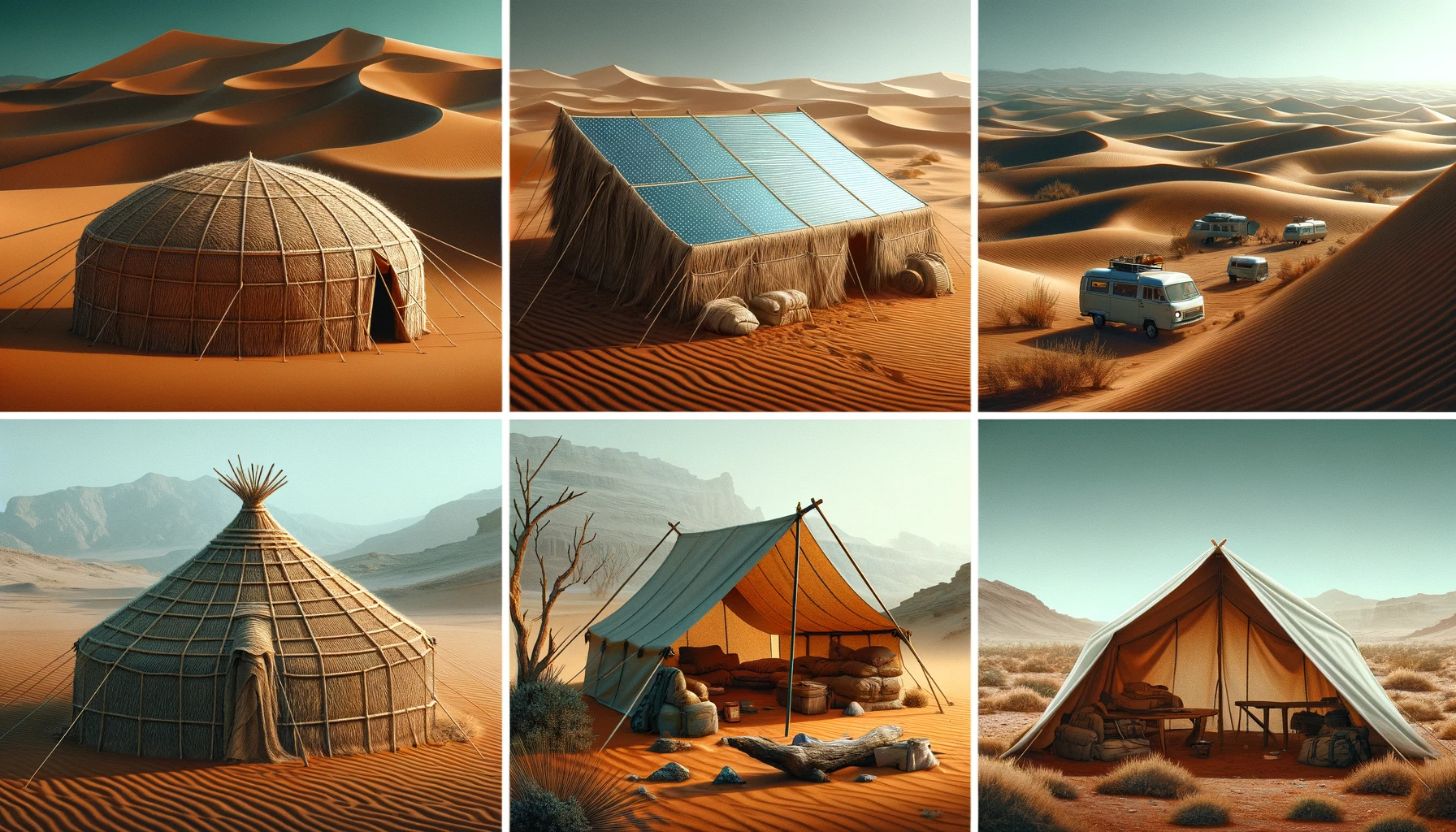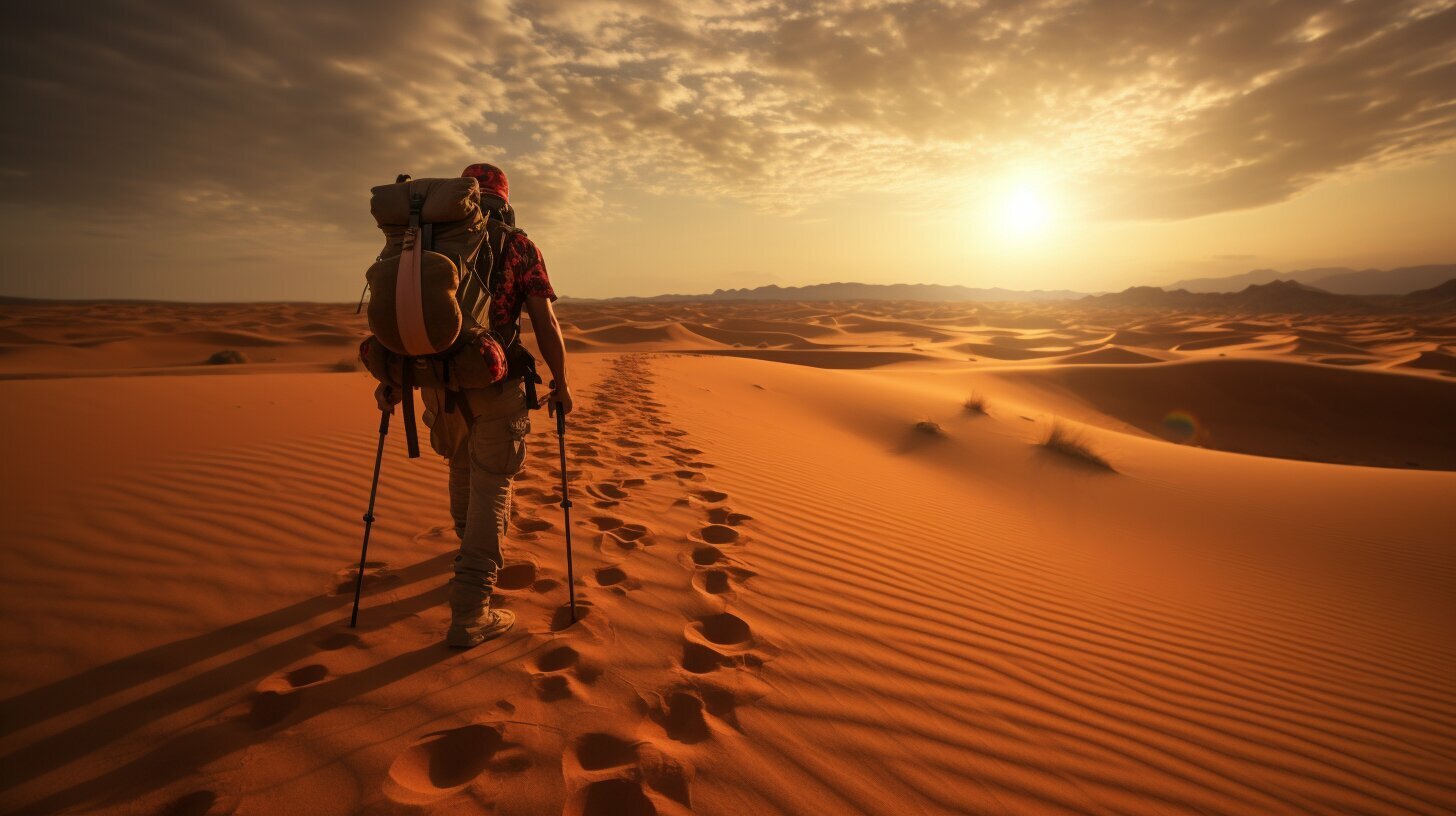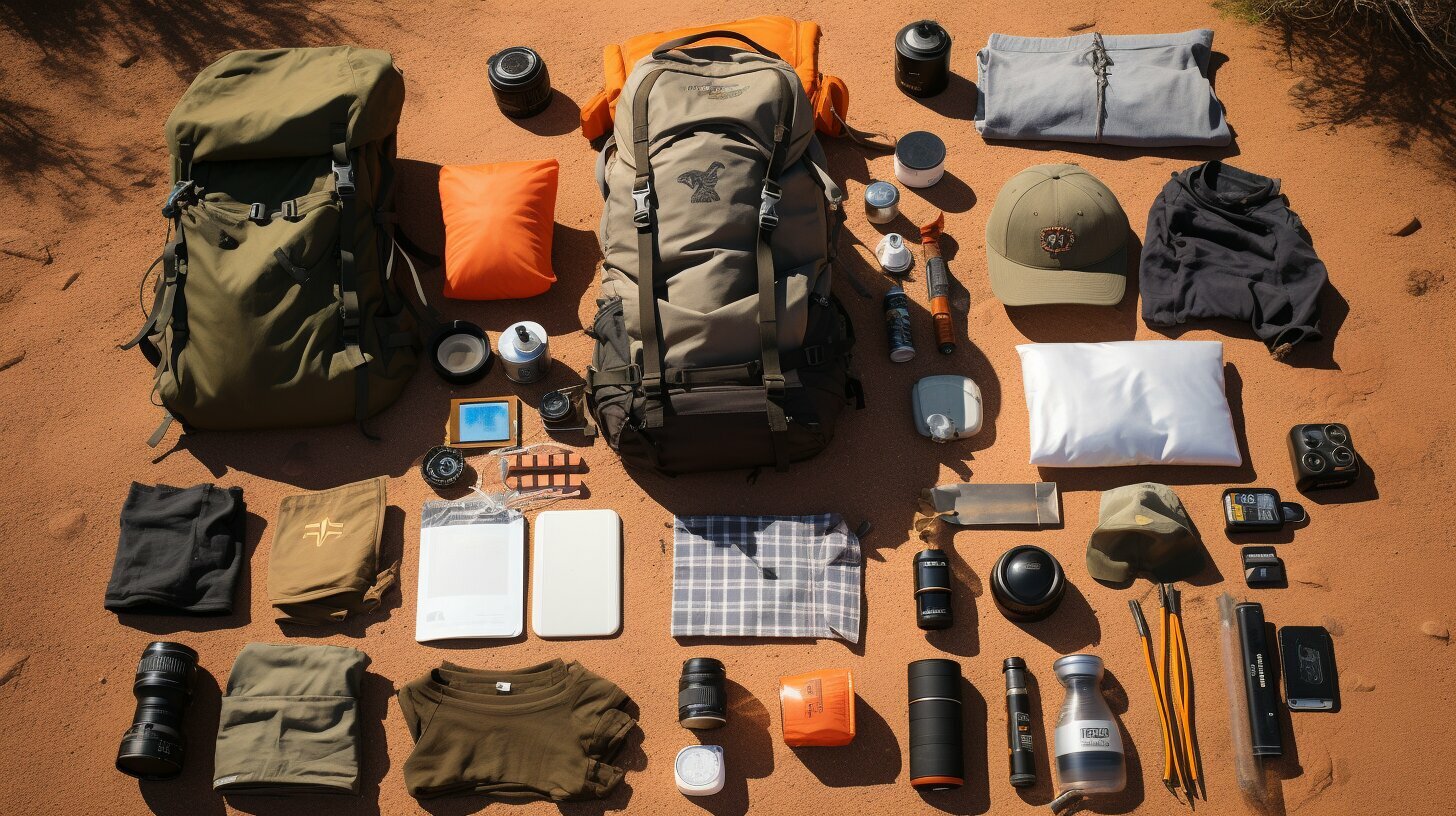Imagine finding yourself stranded in the middle of a vast, arid desert with no food or water in sight. The scorching sun beats down mercilessly on your skin, and the sand seems to stretch endlessly in all directions. It’s an unnerving thought, but it’s a possibility that anyone venturing into the desert must be prepared for.
The harsh environment of the desert presents many challenges when it comes to finding food, and knowing essential tips and tricks for surviving without food in the desert can make all the difference between life and death.
Key Takeaways
- The desert is a harsh, challenging environment when it comes to finding food.
- Essential tips and tricks for desert survival without food can mean the difference between life and death.
Understanding Desert Survival Techniques
Surviving without food in the desert requires a specific set of skills and techniques. Understanding how to conserve energy, find shelter, and stay hydrated are essential for your survival. To increase your chances of making it out alive, it is also crucial to adapt to your surroundings and learn from indigenous desert dwellers. Here are some of the most crucial desert survival techniques:
Conserving Energy
In the harsh desert environment, conserving energy is essential for your survival. Walking or running in the desert uses up more energy than in other environments. To conserve energy, focus on slow and deliberate movement rather than quick bursts of energy. Rest frequently in the shade to avoid overheating and dehydration, and conserve energy by traveling during the cooler parts of the day.
Disclosure: When you buy through links on our site, we may earn an affiliate commission.
Finding Shelter
Shelter is vital in the desert, where shelter from the sun and extreme temperatures can mean the difference between life and death. When searching for shelter, look for natural formations like rocky overhangs, caves, or even large bushes or trees. Avoid exposure to the sun during the hottest parts of the day and use materials like blankets or clothing to protect yourself from the sun’s rays.
Staying Hydrated
Water is the most critical resource in the desert, and staying hydrated is essential for your survival. Carry water with you at all times and ration your water carefully. Look for natural sources of water like natural springs or oases, and be prepared to dig for groundwater. In a survival situation, you can also obtain water from plant transpiration by wrapping a clear plastic bag around a leafy branch with a plastic bag, letting the water gather in the bag.
Adapting to the Surroundings
Adapting to the desert environment is essential for your survival. Learn about the local ecosystem, including the types of plants and animals that live in the area. Take note of landmarks, wind patterns, and natural signs to help you navigate through the desert. Additionally, you can learn from indigenous desert dwellers and their techniques for survival, such as finding water and hunting.
By understanding these crucial desert survival techniques, you can increase your chances of surviving without food in the harsh desert environment.

Water: Your Lifeline in the Desert
When it comes to surviving without food in the desert, finding water is absolutely crucial. Without it, you can quickly become dehydrated, which can lead to serious health problems and even death. Here are some tips on how to find water sources in the desert:
- Look for natural springs: Springs are perhaps the most reliable source of water in the desert. They can be difficult to find, but once you do, they will usually provide a steady flow of fresh water.
- Search for oases: Oases are patches of green vegetation that usually indicate the presence of an underground water source. Look for palm trees and other desert plants that thrive in wet environments.
- Consider digging for groundwater: If you’re in a particularly dry area, you may need to dig for water. Look for areas where the soil is moist or where vegetation is growing, as these are good signs that water is present underground.
Once you’ve found a water source, it’s important to conserve it. Here are some tips to help you make the most of your water:
- Drink small amounts frequently: It’s better to drink small amounts of water throughout the day than to guzzle it all at once. This will help you stay hydrated without wasting water.
- Purify your water: Even if the water looks clean, it may contain harmful bacteria or parasites. Purify it by boiling it for at least 10 minutes or by using a water filter.
- Store water in a cool, dark place: Water stored in direct sunlight will become too hot to drink. Keep it in a shaded area or cover it with a piece of cloth.
Remember, without water, your chances of surviving in the desert are slim. Make finding and conserving water your top priority.
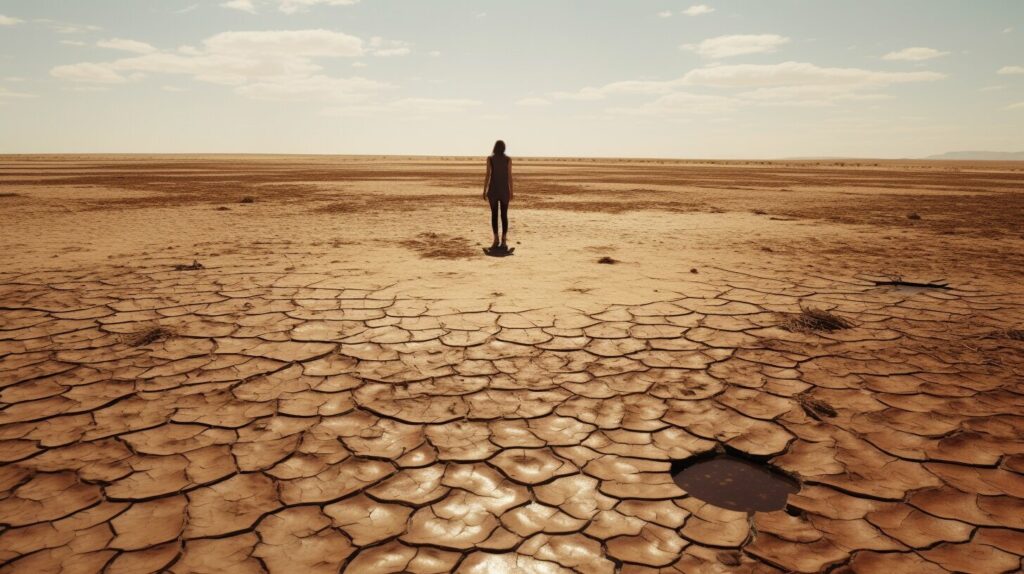
Foraging for Edible Plants in the Desert
If you find yourself stranded in the desert without food, you may have to rely on foraging for edible plants to survive. The desert is home to a variety of plants that can provide valuable nutrients and sustenance. However, it is crucial to have knowledge of which plants are safe to eat, as many are poisonous and potentially deadly.
Identifying Edible Plants
One of the most important skills you can have when foraging for food in the desert is the ability to identify edible plants. Look for plants with recognizable characteristics such as berries, fruits, or nuts. Some examples of edible plants include prickly pear cactus, mesquite, and cholla buds. It is best to start with small portions of any new plant and wait to see if you have a negative reaction before consuming more.
Proper Foraging Techniques
When foraging for food in the desert, it is essential to practice proper techniques to avoid damaging the plant or its surrounding ecosystem. Avoid picking plants that are not fully grown and only take what you need to avoid over-harvesting. If you uproot a plant, make sure to bury the roots and cover the hole to prevent erosion.
Preparing Edible Plants
Once you have identified and harvested edible plants, it is crucial to know how to prepare them properly. Many desert plants have thorns or spines that can be removed with a knife or by roasting them over an open flame. Some plants may need to be soaked in water or boiled to remove toxins before they can be consumed safely.
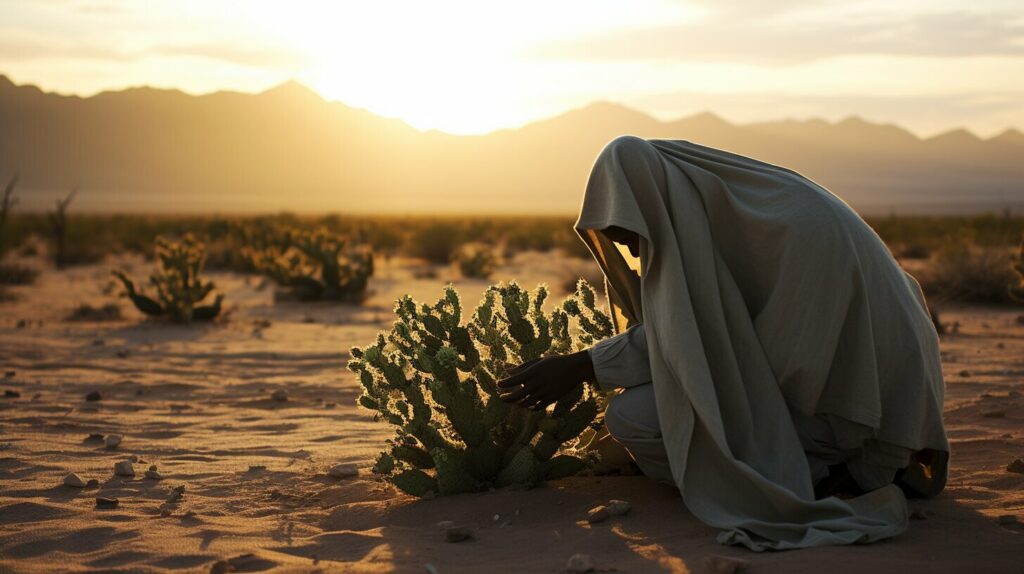
Foraging for edible plants in the desert can be a challenging task, but with the right knowledge and skills, it can also be a lifesaving one. Remember to always be cautious and aware of your surroundings, and only consume plants that you are certain are safe to eat.
Hunting and Trapping in the Desert
When it comes to finding food in the desert, hunting and trapping can be an effective strategy. However, it requires skills, patience, and knowledge of the surrounding wildlife.
Start by identifying the types of animals that are indigenous to the area. Desert animals such as rabbits, lizards, snakes, and insects can be hunted or trapped for food.
Constructing traps and snares can be done using readily available materials such as sticks and vines. One example is the deadfall trap, where a heavy object is set to fall on the prey when triggered. Remember to check the traps frequently and handle the animals safely to prevent injury and potential disease transmission.
When hunting, be mindful of safety and ethical considerations. Never shoot a gun unless you’re sure of your target and what’s beyond it. Consider using a bow and arrow or a slingshot instead.
Remember that hunting and trapping require a significant amount of energy, so use these techniques only when necessary and in combination with other food procurement strategies.
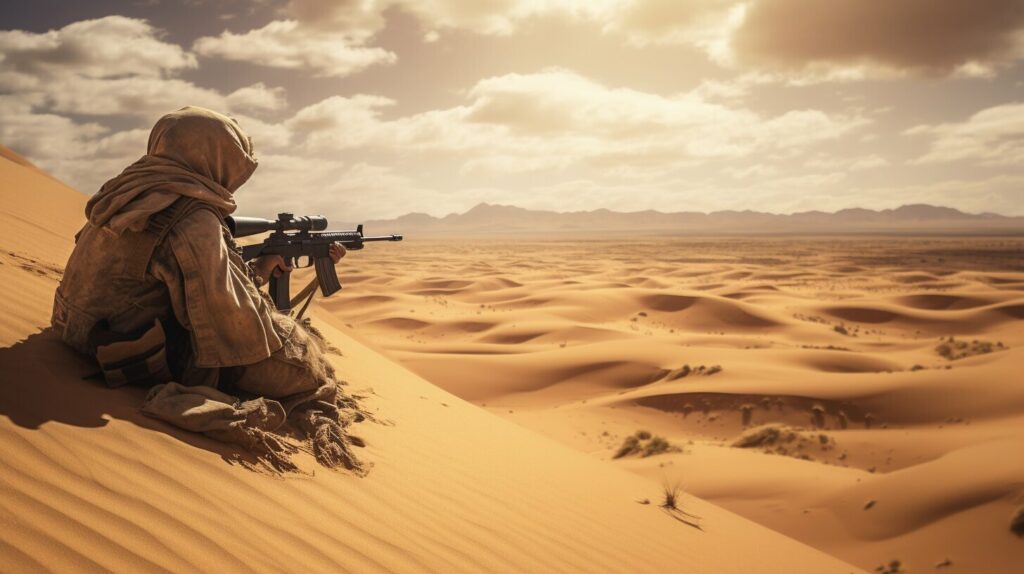
Essential Tools and Equipment for Desert Survival
When it comes to surviving without food in the desert, having the right tools and equipment can make all the difference. The harsh environment can be unforgiving, and you need to be prepared for every situation.
One of the most critical tools is a high-quality knife. A durable, sharp blade can be used for everything from cutting through tough vegetation to preparing food. A compass and map are also essential for navigating the desert terrain, especially if you need to find your way back to civilization.
Other important tools include signaling devices like a mirror or whistle, which can help rescuers locate you if you become lost or injured. You’ll also need fire-starting materials, such as matches or a lighter, to keep warm at night, cook and boil water.
In terms of clothing and gear, make sure to pack lightweight, breathable clothing that will help protect you from the sun and keep you cool. Additional items to pack include a hat, sunglasses, sturdy boots, and a backpack to carry everything you need.
Finally, make sure to pack provisions such as food rations and water bottles and purifying tablets which will come in handy should you not be able to find a source of food.
While it’s essential to have all of these tools and equipment, it’s just as important to know how to use them properly. Make sure to practice using your knife and compass, and learn how to start a fire with different kinds of materials. With the right tools and knowledge, you can increase your chances of surviving in the desert without food.
Understanding the Importance of Energy Conservation
When you’re in the desert without food, your body will start to burn calories fast. Good energy conservation strategies are essential to surviving. You need to manage your energy levels, especially when looking for food and water, building shelter, or navigating the terrain.
Dehydration and starvation can cause physical and mental fatigue, making it harder to survive. Your body can start to shut down, and your morale can plummet. One of the best energy conservation strategies is to avoid overexerting yourself. You need to avoid activities that can cause you to sweat and lose fluids.
When hiking or moving around, take short breaks and frequently rest in shady areas. Minimize activities that require lots of energy, such as running or searching for food for extended periods. Avoid unnecessary movements and conserve your body’s energy as much as possible.
“The best energy conservation strategies are to avoid overexerting yourself. You need to avoid activities that can cause you to sweat and lose fluids.”
Another important energy conservation strategy is to stay hydrated. Dehydration can lead to exhaustion, headache, and poor cognitive ability. Keep water with you at all times, and drink small amounts frequently, even if you don’t feel thirsty. Avoid drinking alcohol, caffeine, or sugary drinks, as they can cause dehydration.
Finally, focus on maintaining a positive mindset. A good attitude can help motivate you to keep going even when things get tough. Practice self-care, take care of your hygiene, and do things that make you feel good and boost your morale.
Remember, energy conservation is a crucial survival skill in the desert. By following these strategies, you can improve your chances of making it through challenging times.
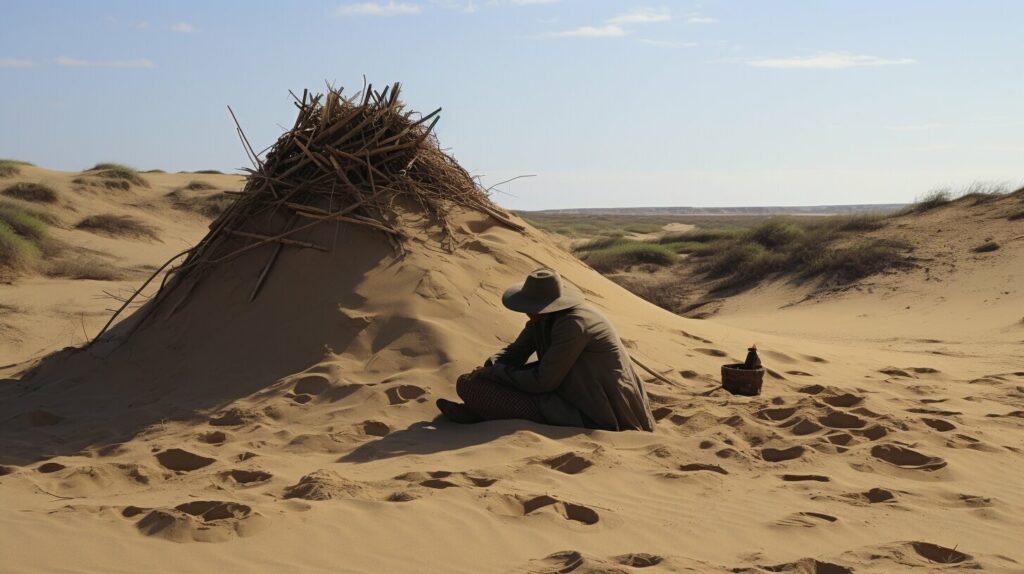
Navigating the Desert: Orientation and Navigation Techniques
When lost in the desert, knowing how to orient and navigate yourself is crucial for survival. Fortunately, there are several techniques you can use to determine directions and avoid getting lost.
Use Landmarks
One of the easiest ways to orient yourself is to look for landmarks, such as mountains or distinctive rock formations. By identifying these features, you can get a general idea of which direction you need to head.
Use Sun and Star Positions
You can also use the position of the sun and stars to determine direction. During the day, the sun rises in the east and sets in the west, so if you can see where the sun is in the sky, you can get a rough idea of which way is east or west. At night, you can use the stars to guide you. The North Star, located in the Little Dipper, always points north.
Look for Natural Signs
Finally, it’s important to keep an eye out for natural signs that can indicate direction. For example, in the northern hemisphere, moss often grows on the north side of trees because it gets less sunlight. Additionally, desert plants tend to lean towards the north because it is cooler and shadier on that side.
Remember to always carry a compass and map to aid in navigation. By using these techniques and tools, you can stay on course and increase your chances of survival in the desert.
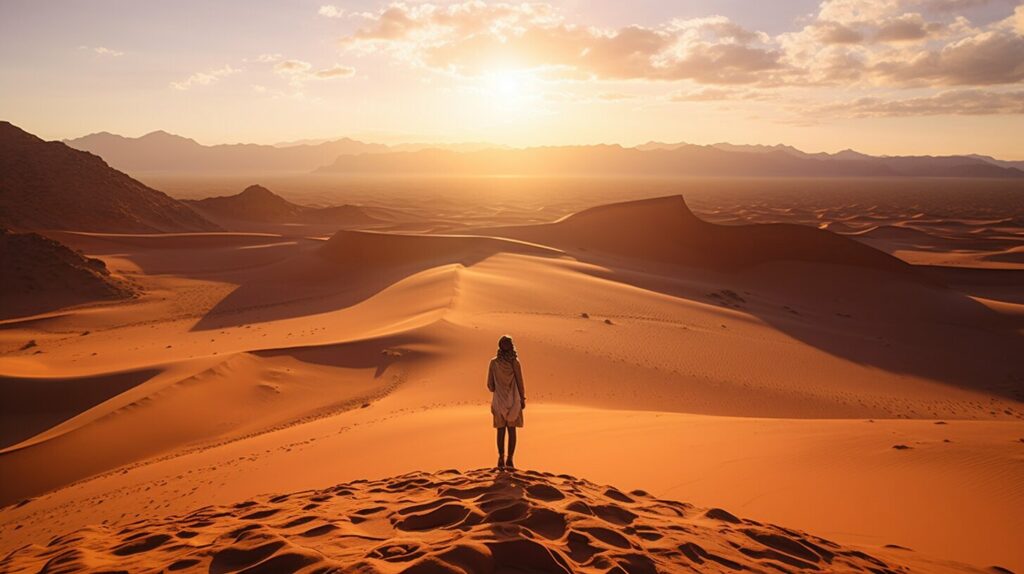
Psychological Strategies for Desert Survival
Surviving without food in the desert is not just a physical challenge, but also a mental one. The isolation, extreme weather conditions, and constant struggle to find sustenance can take a toll on your psyche. To increase your chances of survival, it is crucial to develop psychological strategies to keep your mind focused and positive.
Stay Focused on the Present Moment
When you are in a survival situation, it can be easy to feel overwhelmed by the uncertainty of the future. However, dwelling on the “what-ifs” can deplete your mental energy and make it difficult to focus on the present moment. Instead, try to concentrate on your immediate needs, such as finding water or shelter. By breaking down your survival needs into smaller tasks, you can make the situation more manageable and increase your chances of success.
Find Purpose in the Struggle
Surviving in the desert without food is undoubtedly a challenge, but it can also be an opportunity for personal growth and discovery. Instead of viewing the situation as a test of endurance, try to find purpose in your struggle. Perhaps you can use the experience to develop new skills, connect with nature, or gain a deeper appreciation for life’s simple pleasures. By reframing the experience in a positive light, you can maintain a sense of purpose and motivation.
Celebrate Small Victories
When you are in a survival situation, every small accomplishment counts. Whether it’s finding a source of water, building a shelter, or successfully starting a fire, take time to celebrate your achievements. Recognizing your progress can help boost your morale and keep you motivated to continue your survival efforts.
Practice Self-Compassion
Surviving without food in the desert can be a grueling and exhausting experience. It’s essential to practice self-compassion and give yourself grace during the process. Don’t beat yourself up for mistakes or setbacks along the way. Instead, treat yourself with kindness and understanding, just as you would a friend in a similar situation.
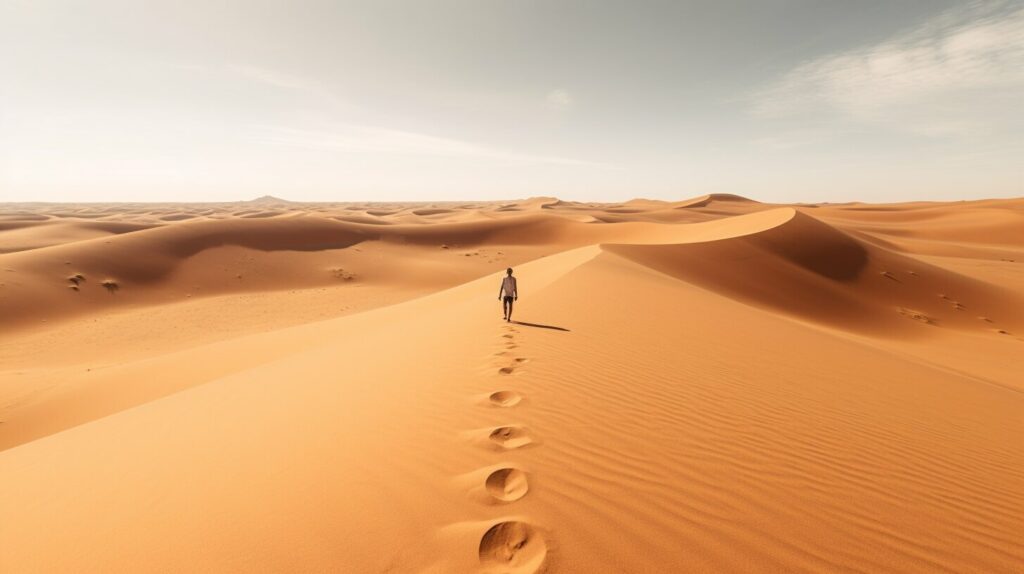
Remember, survival in the desert without food requires both physical and mental resilience. By incorporating psychological strategies into your survival plan, you can increase your chances of making it through even the toughest of situations.
Preparing for Desert Survival: What to Pack and Plan
When it comes to surviving without food in the desert, being prepared is essential. Packing the right supplies and having a solid plan can make the difference between life and death. Here are some items you should consider including in your survival kit:
Food and Water
Pack non-perishable, high-calorie foods such as nuts, energy bars, and dried fruits. Water is also crucial, so make sure to bring enough water containers and a reliable water filtration/purification system. You should aim for at least one gallon of water per person per day.
First Aid Kit
Include essentials such as bandages, antiseptic wipes, pain relievers, and any prescription medications you may need.
Protective Clothing and Gear
The desert is known for its extreme temperatures, so pack clothing that will protect you from the sun and keep you warm at night. Sunglasses, a wide-brimmed hat, and lightweight, long-sleeved clothes are a must. Don’t forget sturdy shoes, a map, a compass, and signaling devices such as a whistle and a mirror.
Communication Devices
Bring at least two forms of communication such as a mobile phone, radio, or satellite messenger. Make sure they are fully charged and have backup batteries.
Survival Shelter
In case you are unable to find natural shelter, pack a lightweight emergency shelter such as a tent, tarp, or bivy sack.
Navigation Aids
Carry a map and a compass. Learn basic navigation techniques to avoid getting lost.
Survival Tools
A knife, fire-starting equipment, and a multitool are essential tools that can be used for hunting, trapping, shelter-building, and more.
Remember, being well-prepared and equipped can help you overcome the challenges of surviving without food in the desert. Pack smart, plan ahead, and stay safe!
Surviving Long-Term in the Desert
Surviving without food in the desert is challenging, but surviving for an extended period requires a unique set of skills and strategies. When facing a long-term survival situation, your main focus should be on energy conservation and resourcefulness.
One of the first steps to take is to establish a reliable water source. This will not only keep you hydrated, but it can also be a source of food if you set up a trap or net to catch small fish or crustaceans.
It’s essential to ration your food supply and find alternative sources of nutrition. Knowing how to identify edible plants and insects can make a significant difference, but be sure to research and test each item before consuming.
In addition to foraging and hunting, it’s crucial to conserve energy by resting in the shade during the hottest parts of the day and avoiding unnecessary exertion. Staying positive and motivated can also improve your chances of survival, so try to find ways to stay occupied and focused.
Remember to be creative with the resources at your disposal. For example, you can use a large leaf or fabric to collect dew in the morning, which can provide an additional source of hydration.
In a long-term survival situation, it’s crucial to maintain a clear and focused mindset. Try to remain calm and approach each challenge with a strategic mindset. If you’re with others, work together to delegate tasks and share resources.
Surviving without food in the desert for an extended period is not easy, but with the right skills and mindset, it’s possible to overcome even the most difficult challenges.
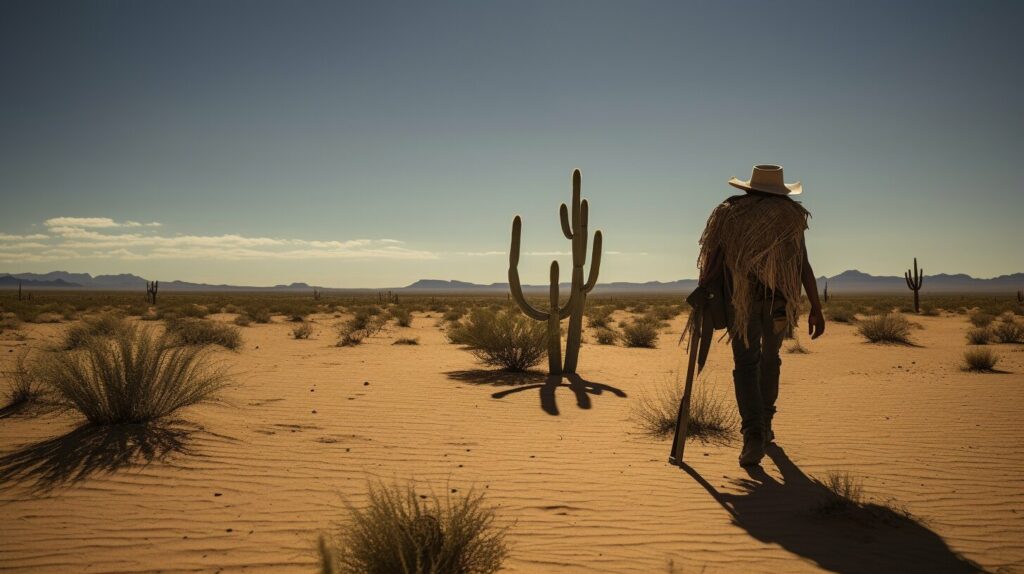
Conclusion
You have now learned some essential tips and tricks for surviving without food in the desert. Remember, the harsh conditions of the desert can make finding sustenance extremely difficult, but with the right techniques and mindset, you can increase your chances of survival.
Always prioritize finding water, as this is your most important lifeline in the desert. Learn how to locate water sources and purify any water you collect. Identify edible plants and animals that can provide nourishment, but be careful not to consume anything that may be poisonous.
Carrying the right tools and equipment is also crucial for desert survival. A knife, compass, and signaling devices can all be invaluable assets when trying to procure food or navigate your way out of the desert.
While the physical challenges of desert survival are undeniable, don’t forget about the psychological aspect. Maintaining a positive attitude and managing stress levels can make all the difference in your ability to survive long-term.
Lastly, it’s important to be prepared and have a solid survival plan in place before venturing into the desert. Make sure to pack all necessary supplies and inform others of your itinerary. With the right preparation and mindset, you can survive without food in the desert.
FAQ
Q: How long can a person survive without food in the desert?
A: The exact duration depends on various factors such as the individual’s health, hydration levels, and environmental conditions. However, the average person can typically survive for about three weeks without food.
Q: Are there any natural sources of food in the desert?
A: While the desert may seem barren, there are certain edible plants and insects that can be found. However, it is essential to have knowledge of desert flora and fauna to identify safe sources of food.
Q: What are some desert survival techniques for finding food?
A: Desert survival techniques for finding food include foraging for edible plants, hunting and trapping small animals, and fishing in water sources if available. It is important to have the necessary skills and tools for these activities.
Q: How can I conserve energy while surviving without food in the desert?
A: To conserve energy, it is crucial to avoid unnecessary physical exertion and prioritize essential tasks. Resting during the hottest parts of the day and avoiding excessive movement can help preserve energy levels.
Q: Is it safe to drink water found in the desert?
A: Water sources in the desert can be contaminated, so it is essential to purify or treat the water before consumption. Boiling, disinfecting tablets, or using a portable water filter are effective methods of water purification.
Q: What should I pack for a desert survival situation?
A: Some essential items to pack for desert survival include a knife, compass, map, signaling devices, fire-starting materials, water containers, food rations, first aid supplies, protective clothing, and communication devices.
Q: How can I navigate in the desert without getting lost?
A: Orienting yourself in the desert can be challenging, but you can use landmarks, sun and star positions, and natural signs to determine directions. It is also helpful to create a basic navigation plan and stay mindful of your surroundings.
Q: What are some psychological strategies for desert survival?
A: Maintaining a positive mindset, staying focused, and managing stress and anxiety are crucial in desert survival situations. Techniques such as meditation, visualization, and positive self-talk can be helpful in maintaining psychological well-being.
Q: How can I prepare for long-term survival in the desert?
A: Preparing for long-term survival in the desert involves having a comprehensive survival plan, including adequate food and water supplies, protective clothing, shelter-building materials, and knowledge of sustainable food sources and foraging techniques.
Q: What should I do if I find myself lost in the desert without food?
A: If you find yourself lost in the desert without food, it is crucial to stay calm and conserve your energy. Look for sources of water and edible plants, and if possible, try to attract attention for rescue.

